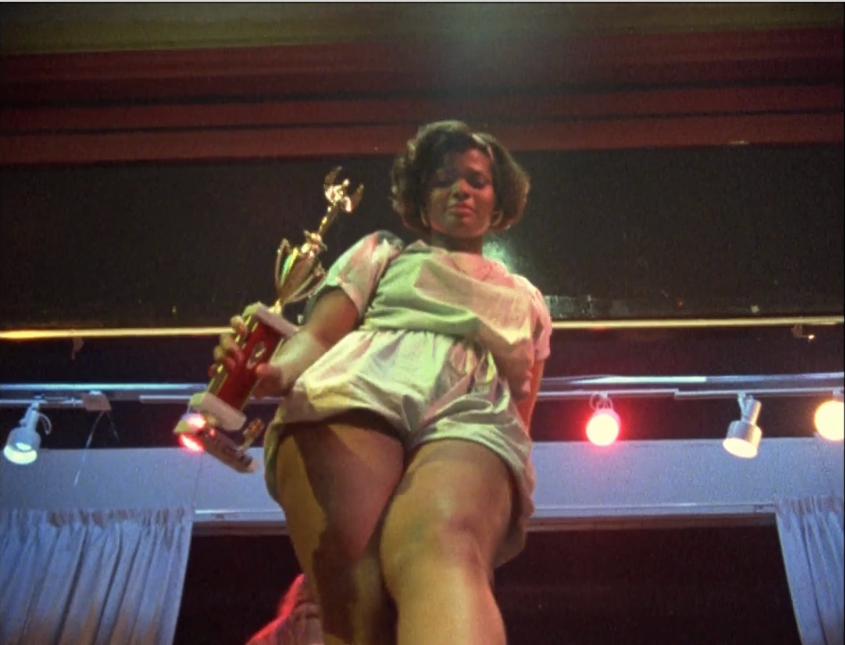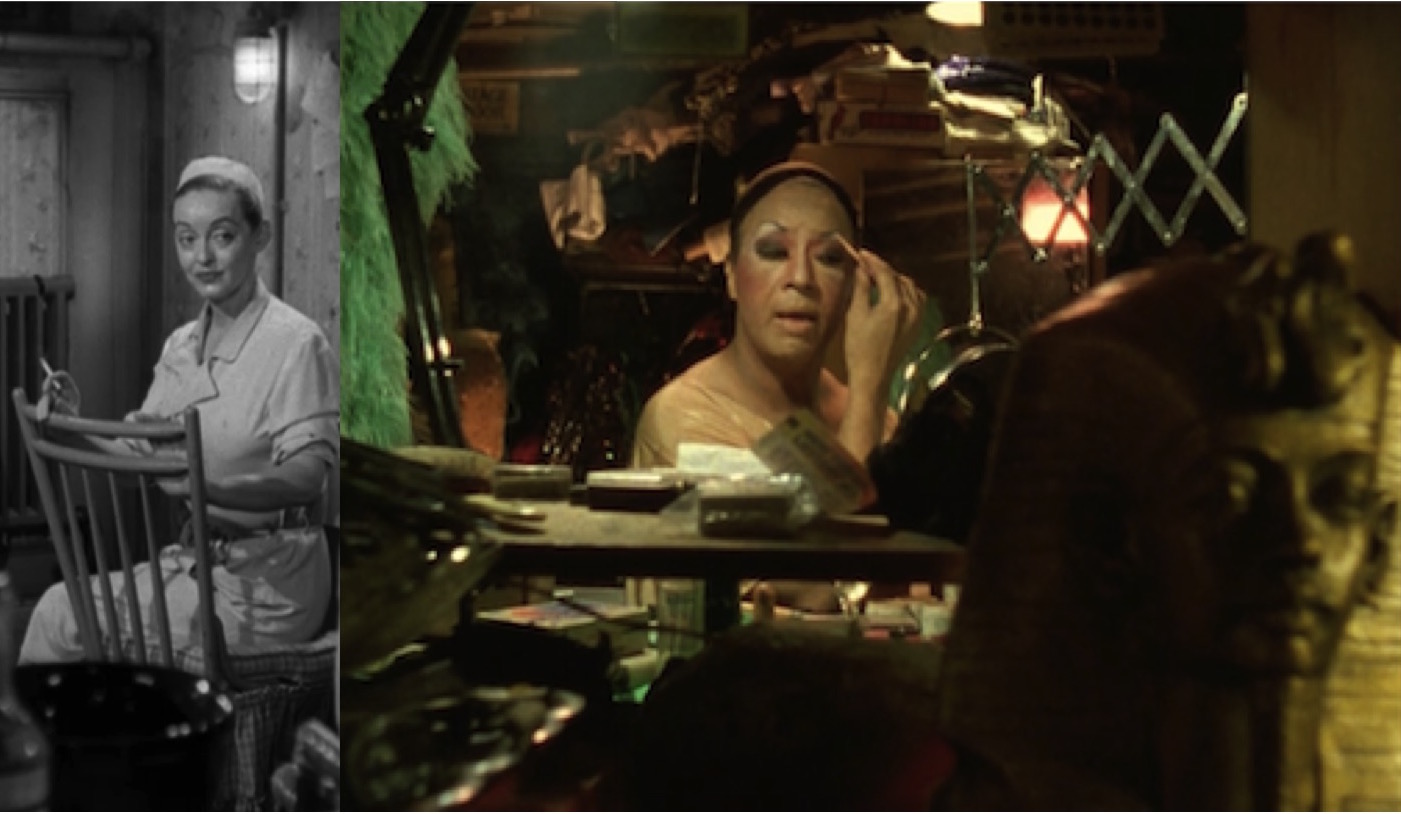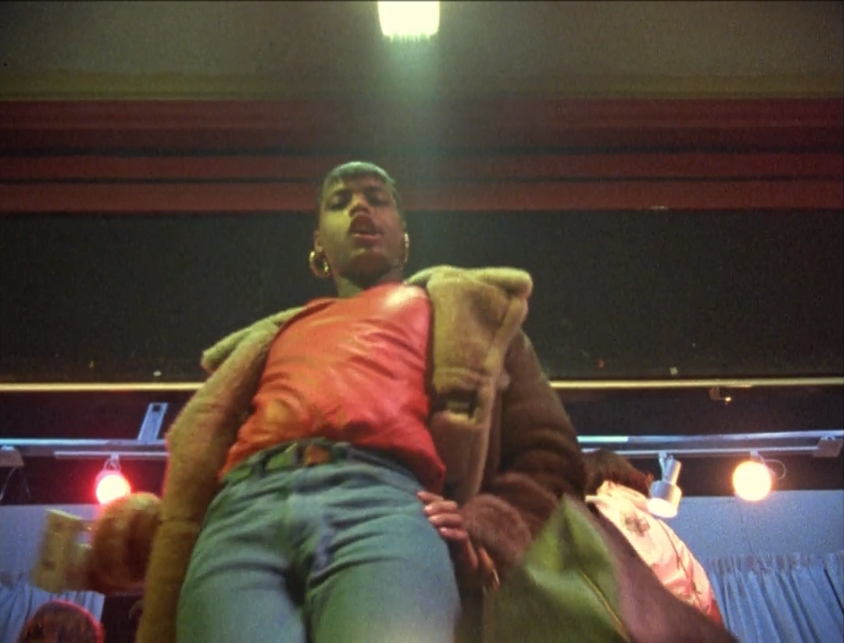I had seen Paris Is Burning (1990) once before, but since I watched it as homework for a class on “Black Subjectivity” (whatever that means), I was mostly interested in it as a piece of ethnography. Rewatching it for this week’s #HMWYBS challenge with an eye for cinematography helped me appreciate how well-constructed it is, and how crucial such things as lighting and camera angle are for even a nonfiction film with a miniscule budget.
The movie profiles the drag balls that were popular among queer people of color in New York City, many of them very poor, through the 1980s. The shot that I want to highlight (below) appears when the discussion turns to the categories in which the ball’s participants are able to compete. One category rewards performers for looking “real”—that is, for persuasively concealing their sexual difference by dressing and strutting as though they were straight biological men or women. I found this segment heart-wrenching because I spent some of the best years of my life believing that if I acted manly/straight I might convince myself that I was. From my vantage point several years later, it feels clear that by hiding their difference in order to satisfy society’s desire to lump them into legible gender identities these performers are suppressing what is most unique and valuable about them.
 The cinematography underscores the triumph and tragedy of being named the “most real.” After collecting their trophies, the winners step down from the stage, struggling with all their might not to let their joy disrupt the continuity of their performances. The camera points upward, capturing an intimate look at their facial expressions but also reinforcing the self-confidence the category seems designed to recognize. The whole scene is reminiscent of an Oscars ceremony, which is appropriate given the number of times the balls’ participants share their admiration for (white) Hollywood beauties such as Marlene Dietrich and Marilyn Monroe. Of course, I don’t think many actual “Hollywood beauties” would stand for being filmed at this up-the-skirt angle.
The cinematography underscores the triumph and tragedy of being named the “most real.” After collecting their trophies, the winners step down from the stage, struggling with all their might not to let their joy disrupt the continuity of their performances. The camera points upward, capturing an intimate look at their facial expressions but also reinforcing the self-confidence the category seems designed to recognize. The whole scene is reminiscent of an Oscars ceremony, which is appropriate given the number of times the balls’ participants share their admiration for (white) Hollywood beauties such as Marlene Dietrich and Marilyn Monroe. Of course, I don’t think many actual “Hollywood beauties” would stand for being filmed at this up-the-skirt angle.
The camera understands that at these competitions “most real” actually means “most fake.” I mentioned that the upward angle reveals the winners’ faces, but it also captures a close look at the parts of the body that we might suppose have been tucked away or added onto for the sake of the competition. Other shots from this sequence linger on the contestants’ breasts (below), but in the one that I have selected the focal point is clearly the pelvis. The line created by the performer’s right hand plus the stage lights passing right behind her* rear end leads our eyes directly to her crotch. Even the spacing of the lights conspires in forcing us to look up the woman’s shorts: Red bulbs flash on either side of her thighs, and the one equally distant on the line between them is in exactly the same position as her groin. Placing the pelvis front and center surely reinforces the celebrated “realness” of this individual’s performance as a biological woman because it dares us to inspect the area for erroneous anatomy. But demanding that we admire the crotch for irregularities also confirms what Judith Butler was calling the “performativity” of gender around the same time that the movie was produced. It invites us to revel in what looks like a perfect deception–but a deception nonetheless.
Honorable Mention: Before closing, I want to share that I also *loved* how some of the film’s interview segments were shot. Most documentaries have their subjects look right at the camera as if they were defendants or witnesses in a trial and the audience a judge or jury with the right to determine the veracity of their testimony. Not so with Paris Is Burning. Here, several people being interviewed carry on with their preparation for the ball, stitching garments, applying makeup, etc. This results in intimacy, since we feel that these people have let us into one of their most private moments, but also a kind of defiance: If we’re making judgments about their lives or appearance, well, they’re too busy doing more important things to care or even notice.
 My favorite of the interview shots is the one honoring the Best Movie Ever Made–a.k.a. All About Eve (1950). Dorian Corey, like Margot Channing, feels the pressure of young legends-to-be nipping at his heels but seems to understand that his best strategy for keeping his real insecurities hidden is to look confident in other states of expected vulnerability. The composition of this shot is spectacular, framing Corey with the tools of the trade, so to speak, while also lending depth to what is probably very tight quarters. The shot includes the pharaoh that brings exotic gold surfaces to various scenes. In this case, the statue also foreshadows the actual mummy that would be discovered among Corey’s possessions at the time of his death in 1993 (RIP).
My favorite of the interview shots is the one honoring the Best Movie Ever Made–a.k.a. All About Eve (1950). Dorian Corey, like Margot Channing, feels the pressure of young legends-to-be nipping at his heels but seems to understand that his best strategy for keeping his real insecurities hidden is to look confident in other states of expected vulnerability. The composition of this shot is spectacular, framing Corey with the tools of the trade, so to speak, while also lending depth to what is probably very tight quarters. The shot includes the pharaoh that brings exotic gold surfaces to various scenes. In this case, the statue also foreshadows the actual mummy that would be discovered among Corey’s possessions at the time of his death in 1993 (RIP).
*In this post, I have attempted to use pronouns reflecting the gender identity the person in question seems to be performing. I will readily admit that it’s an imperfect approach and apologize in advance for using them wrong.

this was a great read – thanks! and i had no idea about the mummy dorian corey had until reading this and now i’m obsessed!
Yeah. Isn’t that nuts?!